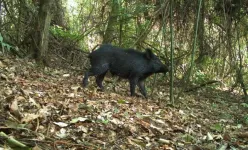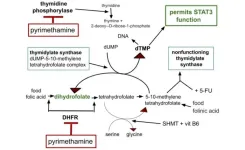(Press-News.org) Snail shells are often colourful and strikingly patterned. This is due to pigments that are produced in special cells of the snail and stored in the shell in varying concentrations. Fossil shells, on the other hand, are usually pale and inconspicuous because the pigments are very sensitive and have already decomposed. Residues of ancient colour patterns are therefore very rare. This makes this new discovery by researchers from the University of Göttingen and the Natural History Museum Vienna (NHMW) all the more astonishing: they found pigments in twelve-million-year-old fossilised snail shells. These are the world's first pigments from the chemical group of polyenes that have been preserved almost unchanged and found in fossils. The study was published in the journal Palaeontology.
Palaeontologists from the NHMW found snail shells of the superfamily Cerithioidea in Burgenland, Austria. The snails lived there twelve million years ago on the shores of a tropical sea. Professor Mathias Harzhauser at NHMW, who was involved in the discovery, explains: "It was unclear whether the patterns of reddish colour were from the original shell or were formed by later processes in the sediment." Researchers at Göttingen University’s Geoscience Center solved the mystery. They analysed the pigments using Raman spectroscopy. This involves irradiating samples with laser light. The scattered light reflected from the sample can be used to clearly identify chemical compounds. They detected pigments in the fossilised shells that belong to the polyene group of chemicals. These are organic compounds that include the well-known “carotenoids”, which are responsible for producing the vibrant red, orange and yellow colours seen in birds’ feathers, carrots and egg yolks, for instance.
Dr Klaus Wolkenstein, who led the study and has been researching the chemistry of fossil pigments at Göttingen University for many years, explains: "Normally, after such a long period of time, the best we can hope for is that there are traces of degradation products of these chemicals. If degraded, however, these compounds would be devoid of colour. So, it was really surprising to discover these pigments, preserved almost intact, in fossils that are twelve million years old."
Original publication: Wolkenstein, K. et al. Detection of intact polyene pigments in Miocene gastropod shells. Palaeontology (2024). DOI: 10.1111/pala.12691
Contact:
Dr Klaus Wolkenstein
University of Göttingen
Geoscience Center, Geobiology
Goldschmidtstraße 3, 37077 Göttingen, Germany
Tel: +49 (0)551 39-7962
Email: klaus.wolkenstein@uni-goettingen.de
www.uni-goettingen.de/en/653377.html
Professor Mathias Harzhauser
Natural History Museum Vienna
Tel: +43 (0)1 52177-250
Email: mathias.harzhauser@nhm-wien.ac.at
END
Surprisingly vibrant colour of 12-million-year-old snail shells
Researchers provide world's first evidence of intact polyene pigments in fossils
2024-02-09
ELSE PRESS RELEASES FROM THIS DATE:
In the Cerrado, crop diversification has beneficial effects on wildlife and reduces the presence of boars
2024-02-09
There are no substitutes for native vegetation, but replacing large areas of monoculture with diversified crops in places where agricultural activities are widespread can have beneficial effects on the mammals that still inhabit the region.
This is one of the conclusions of a study conducted by researchers at the University of São Paulo (USP) supported by FAPESP. They focused on the northeast of São Paulo state, where the predominant biome is the Cerrado (Brazilian savanna). The region is one of the nation’s agribusiness centers.
An article on the study is published in the Journal of Applied Ecology. The study showed that ...
How electron spectroscopy measures exciton “holes”
2024-02-09
Semiconductors are ubiquitous in modern technology, working to either enable or prevent the flow of electricity. In order to understand the potential of two-dimensional semiconductors for future computer and photovoltaic technologies, researchers from the Universities of Göttingen, Marburg and Cambridge investigated the bond that builds between the electrons and holes contained in these materials. By using a special method to break up the bond between electrons and holes, they were able to gain a ...
IPIAD: an augmentation to standard treatment of PDAC using five repurposed drugs
2024-02-09
“This paper presents the rationale for adding five already approved and marketed generic drugs from general medical practice to the current standard current first line chemotherapy for pancreatic ductal adenocarcinoma (PDAC).”
BUFFALO, NY- February 9, 2024 – A new research perspective was published in Oncoscience (Volume 11) on February 7, 2024, entitled, “IPIAD- an augmentation regimen added to standard treatment of pancreatic ductal adenocarcinoma using already-marketed repurposed drugs irbesartan, pyrimethamine, itraconazole, azithromycin, and dapsone.”
In this new paper, researcher Richard E. Kast from IIAIGC Study Center presents the ...
UT Health San Antonio School of Dentistry opens dental clinic for special-needs children, adults
2024-02-09
SAN ANTONIO, Feb. 9, 2024 – The UT Health San Antonio School of Dentistry has opened a special-care dental clinic, the first of its kind in an academic setting in South Texas that will serve people of all ages with intellectual, developmental, cognitive or physical disabilities.
With spacious, specially designed treatment rooms featuring adjustable sound and lighting and even a “Zen Den” multi-sensory room to help reduce anxiety, the Phil and Karen Hunke Special Care Clinic occupies approximately ...
This ultrasound sticker senses changing stiffness of deep internal organs
2024-02-09
MIT engineers have developed a small ultrasound sticker that can monitor the stiffness of organs deep inside the body. The sticker, about the size of a postage stamp, can be worn on the skin and is designed to pick up on signs of disease, such as liver and kidney failure and the progression of solid tumors.
In an open-access study that will appear in Science Advances, the team reports that the sensor can send sound waves through the skin and into the body, where the waves reflect off internal organs and back out to the sticker. The pattern of the reflected waves can be read as ...
Yale joins the ‘Snowball’ fight over global deep freeze periods
2024-02-09
New Haven, Conn. — A Yale-led research team has picked a side in the “Snowball Earth” debate over the possible cause of planet-wide deep freeze events that occurred in the distant past.
According to a new study, these so-called “Snowball” Earth periods, in which the planet’s surface was covered in ice for thousands or even millions of years, could have been triggered abruptly by large asteroids that slammed into the Earth.
The findings, detailed in the journal Science Advances, may answer a question ...
Sensors made from ‘frozen smoke’ can detect toxic formaldehyde in homes and offices
2024-02-09
Researchers have developed a sensor made from ‘frozen smoke’ that uses artificial intelligence techniques to detect formaldehyde in real time at concentrations as low as eight parts per billion, far beyond the sensitivity of most indoor air quality sensors.
The researchers, from the University of Cambridge, developed sensors made from highly porous materials known as aerogels. By precisely engineering the shape of the holes in the aerogels, the sensors were able to detect the fingerprint of formaldehyde, a common indoor air pollutant, at room temperature.
The proof-of-concept sensors, which require minimal power, could be adapted to detect ...
University Hospitals now offering FDA-approved medication for treatment of Alzheimer’s disease
2024-02-09
CLEVELAND—University Hospitals (UH) Brain Health & Memory Center is now treating patients with LEQEMBI® (lecanemab), a Food and Drug Administration-approved medication for the treatment of Alzheimer’s disease.
“Those with Alzheimer’s disease often have an abnormal buildup of plaques in their brain that contain a protein called beta-amyloid,” said Charles J. Duffy, MD, PhD, neurologist and Director of the Brain Health & Memory Center within the UH Neurological Institute. “Lecanemab ...
Unlocking quantum precision: Expanded superconducting strips for enhanced photon-counting accuracy
2024-02-09
Using single photons as qubits has become a prominent strategy in quantum information technology. Accurately determining the number of photons is crucial in various quantum systems, including quantum computation, quantum communication, and quantum metrology. Photon-number-resolving detectors (PNRDs) play a vital role in achieving this accuracy and have two main performance indicators: resolving fidelity, which measures the probability of accurately recording the number of incident photons, and dynamic range, which describes the maximum resolvable photon number.
Superconducting nanostrip single-photon detectors (SNSPDs) are considered the leading ...
From growing roots, clues to how stem cells decide their fate
2024-02-09
DURHAM, N.C. -- It might look like a comet or a shooting star, but this time-lapse video is actually a tiny plant root, not much thicker than a human hair, magnified hundreds of times as it grows under the microscope.
Researchers at Duke University have been making such movies by peering at stem cells near the root’s tip and taking snapshots as they divide and multiply over time, using a technique called light sheet microscopy.
The work offers more than a front row seat to the drama of growing roots. By watching how the cells divide in response to certain chemical signals, the team is finding new clues to how stem cells choose one ...
LAST 30 PRESS RELEASES:
Global psychiatry mourns Professor Dan Stein, visionary who transformed mental health science across Africa and beyond
KIST develops eco-friendly palladium recovery technology to safeguard resource security
Statins significantly reduce mortality risk for adults with diabetes, regardless of cardiovascular risk
Brain immune cells may drive more damage in females than males with Alzheimer’s
Evidence-based recommendations empower clinicians to manage epilepsy in pregnancy
Fungus turns bark beetles’ defenses against them
There are new antivirals being tested for herpesviruses. Scientists now know how they work
CDI scientist, colleagues author review of global burden of fungus Candida auris
How does stroke influence speech comprehension?
B cells transiently unlock their plasticity, risking lymphoma development
Advanced AI dodel predicts spoken language outcomes in deaf children after cochlear implants
Multimodal imaging-based cerebral blood flow prediction model development in simulated microgravity
Accelerated streaming subgraph matching framework is faster, more robust, and scalable
Gestational diabetes rose every year in the US since 2016
OHSU researchers find breast cancer drug boosts leukemia treatment
Fear and medical misinformation regarding risk of progression or recurrence among patients with breast cancer
Glucagonlike peptide-1 receptor agonists and asthma risk in adolescents with obesity
Reviving dormant immunity: Millimeter waves reprogram the immunosuppressive microenvironment to potentiate immunotherapy without obvious side effects
Safety decision-making for autonomous vehicles integrating passenger physiological states by fNIRS
Fires could emit more air pollution than previously estimated
A new way to map how cells choose their fate
Numbers in our sights affect how we perceive space
SIMJ announces global collaborative book project in commemoration of its 75th anniversary
Air pollution exposure and birth weight
Obstructive sleep apnea risk and mental health conditions among older adults
How talking slows eye movements behind the wheel
The Ceramic Society of Japan’s Oxoate Ceramics Research Association launches new international book project
Heart-brain connection: international study reveals the role of the vagus nerve in keeping the heart young
Researchers identify Rb1 as a predictive biomarker for a new therapeutic strategy in some breast cancers
Survey reveals ethical gaps slowing AI adoption in pediatric surgery
[Press-News.org] Surprisingly vibrant colour of 12-million-year-old snail shellsResearchers provide world's first evidence of intact polyene pigments in fossils







